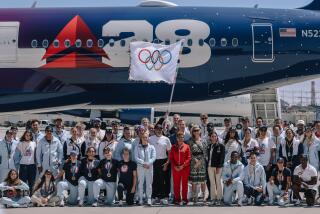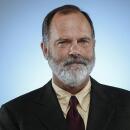Mayor to Embark on Complex Journey to Asia
- Share via
Mayor Richard Riordan leaves today for Asia on the longest, most expensive and most complicated trip of his administration--a trade mission to a region in economic crisis and a diplomatic foray to countries where relations are perilously complex.
Not to mention that the two-week journey is what passes for a mayoral honeymoon, as it will mark the first trip in which the newlyweds Richard and Nancy Daly Riordan will travel as husband and wife.
Billed as a “business and friendship mission,” the trip will take Riordan and 80 other city officials and business leaders to Japan, South Korea, China and Taiwan. That is the largest such city delegation ever to venture an overseas trip. And at a cost of more than $400,000 to taxpayers, it also is by far the most expensive.
Critics have seized on the cost of the trip and the composition of the delegation, but even skeptics acknowledge that it could easily pay for itself in increased business for Los Angeles and improved relations with key trading partners. Among other things, Riordan is slated to meet with the emperor and empress of Japan, attend the inauguration of South Korea’s new president and meet with top Chinese leaders.
“This is the most complicated trip the mayor has taken,” said Deputy Mayor Stephanie Bradfield, who has coordinated planning for the event. “It also has the most potential payoff.”
The journey will pick up where Riordan left off during an ill-fated 1995 trip halted by the verdicts in the O.J. Simpson criminal trial, which prompted the mayor to return to Los Angeles rather than be thousands of miles away at such a delicate and potentially explosive time.
In its initial incarnation, the current trip was intended as a traditional trade mission, with Riordan stumping for tourism and dropping by regional powerhouse companies to persuade them to step up their business with Los Angeles. But with Asia in economic turmoil, the trip’s emphasis has been refocused, mostly away from big companies and toward small and medium-size ones.
In addition, the mayor and other city staffers hope to use their visits to drum up business for the expanding Los Angeles Port and the anticipated growth of Los Angeles International Airport. Those two facilities already anchor the city’s foreign trade, and Los Angeles officials are aggressively marketing them to companies looking to expand their business in the western United States.
Even as they pitch their case abroad, however, officials face considerable local opposition to both airport and port expansion. In the harbor area, a vocal group of residents has raised a host of concerns about environmental issues, while at the airport City Councilwoman Ruth Galanter has kept up a steady drumbeat of opposition to the expansion plans.
Galanter instead advocates expansion of the Palmdale airport, and this week wrote to airport Executive Director Jack Driscoll urging him not to ignore Palmdale’s place in the region’s airport development.
Galanter wants the city to focus on Palmdale because she supports increases in traffic to the region but does not want LAX to bear the entire burden.
“The problem with the master plan is that nobody at the Department of Airports is asking the right questions relating to airport expansion,” Galanter said. “The question is not whether Palmdale is feasible right now; the question is what do we need to do to make Palmdale a viable option.”
On another front, airport expansion could run into the byzantine politics of labor. Riordan likes to boast that expansion is supported “100%” by organized labor, but in fact, some union activists are concerned that no promises have yet been made about whether jobs in the expanded airport would pay so-called living wages, as opposed to federal minimum wages.
One result is that minimum-wage advocates in the city’s labor movement are eyeing the proposal warily while the building and construction trades are eagerly behind it.
Those issues have done little to squelch Riordan’s enthusiasm for airport and port growth, however, and as he travels to Asia, a major part of his message is that Los Angeles is expanding trade opportunities by the bushel.
A recent study of the Los Angeles economy echoes the importance that Riordan places on international trade and the city’s need to encourage it.
“By furnishing convenient and direct access to global markets, the Los Angeles/Long Beach ports and airports are a major reason why trade plays such a significant role in regional and state economies,” the study, written by UC San Diego professor Steven P. Erie, concluded. “Global trade promises to play an even greater role in the future.”
Drumming up trade opportunities is Riordan’s mission of the moment, and his itinerary for the two-week Asian trip is brimming with private meetings, blending the diplomatic and the economic but with the emphasis usually on business.
As the mission’s focus has broadened and shifted, the size of the delegation has boomed. More than 80 people, most but not all traveling at their own expense, will visit one or more of the eight cities on Riordan’s itinerary. The tab of more than $400,000 will cover city officials and a portion of the expenses of representatives of the Los Angeles Convention and Visitors Bureau. The mayor and his wife are among those paying their own way.
Visits are targeted to the cities where Riordan aides believe they can have the most impact.
Toy sellers Charlie and Peter Woo, for instance, will accompany the mayor to China, where many of their toys are made. Police Commission President Edith Perez will join Riordan in Japan, where tourist traffic to Los Angeles is hampered by a fear of crime here. In Taipei, Taiwan, shipping company executives will accompany the mayor as he tries to lure business for Los Angeles’ port. And in Beijing, entertainment industry executives will make their pitch for a piece of the growing Chinese market for music and television programming.
The process for selecting the delegation--targeting industries that seemed to be bearing up under the troubled Asian economic situation and then trying to identify local companies that could profit by the trip--resulted in a group that is less ethnically diverse than the city as a whole. City Councilman Mike Hernandez complained about that Tuesday, but Deputy Mayor Bradfield said that criticism was unwarranted.
“We were looking at where there were marketing possibilities,” she said. “Ethnicity is not the first measure that we apply to everything, although it’s certainly a consideration.”
The scope of the trip also has drawn some mild criticism from officials mindful of its cost. The total city bill for the trip is estimated at $469,775, and Controller Rick Tuttle, who has occasionally sparred with the mayor, has questioned the size of the effort.
In response, the City Council conducted an odd debate Tuesday in which it ultimately voted 13 to 1 to endorse the trip. Only Councilwoman Rita Walters voted against it, saying she was troubled by the expense.
Under Mayor Tom Bradley, Riordan’s predecessor, foreign travel was far more frequent but much less expensive. An official in the controller’s office said Bradley’s trips generally averaged about $200,000, but also usually were limited to visiting sister cities and encouraging tourism.
Although the trip’s rapid-fire series of meetings and diplomatic functions leaves little leisure time, one stop carries special personal significance for Riordan. On Feb. 28, he will tour the joint security area that acts as a buffer between North and South Korea. Riordan, who will be joined on that tour by his wife of two weeks, served in the Korean War in that area in 1951.
More to Read
Get the L.A. Times Politics newsletter
Deeply reported insights into legislation, politics and policy from Sacramento, Washington and beyond. In your inbox twice per week.
You may occasionally receive promotional content from the Los Angeles Times.











